Noticias
ChatGPT predicts all 32 first-round picks in 2025
2025 NFL Draft offers tons of offensive and defensive line help
USA TODAY Sports’ Tyler Dragon breaks down the deepest part of the 2025 NFL Draft, offensive and defensive lineman.
Sports Pulse
Mock drafts can be like steak. Many people love consuming them, but each one is made a little differently.
And just as some people like their steaks with A1 sauce, others like to see what happens when AI completes a mock draft.
USA TODAY Sports consulted OpenAI’s AI chatbot, ChatGPT, for its take on a first-round mock draft ahead of the 2025 NFL draft. Artificial intelligence made its selection for each pick and added some of its own justifications for them as well.
Though each pick was one that ChatGPT eventually landed on, a human writer made sure that each selection was a (relatively) realistic pick for each of the 32 teams.
Here’s how the first round of the 2025 NFL draft could go, according to ChatGPT:
2025 NFL mock draft: ChatGPT’s first-round picks
1. Tennessee Titans: Cam Ward, QB, Miami (FL)
With the first overall pick in the 2025 NFL draft, ChatGPT did not stray from the status quo. The AI chatbot pointed to Tennessee’s major need for a quarterback with Will Levis not proving he’s a long-term answer and “a new regime possibly wanting their own guy.”
The Titans hired Mike Borgonzi as their new general manager in January, and head coach Brian Callahan will be entering his second season in charge in Nashville.
2. Cleveland Browns: Travis Hunter, CB/WR, Colorado
Though quarterback is a draft need for Cleveland, ChatGPT ultimately did not go for the No. 2 quarterback in the draft – Colorado’s Shedeur Sanders – with the No. 2 overall pick. Instead, it selected Sanders’ teammate, Hunter, pointing to his versatility to play both wide receiver and cornerback at an “elite level—basically two first-rounders in one,” it wrote.
3. New York Giants: Abdul Carter, Edge, Penn State
No quarterback for “Big Blue” if ChatGPT has anything to say about it. The chatbot had also considered quarterback Shedeur Sanders and defensive tackle Mason Graham with the third pick, but it ultimately couldn’t pass up the opportunity to pair Carter with Kayvon Thibodeaux and Brian Burns in the Giants’ pass rush.
“That’s a nightmare for opposing QBs … If you can’t land your QB (like Ward), then ruin other people’s QBs instead.”
The OpenAI product also suggested Sanders’ NFL readiness was too questionable for New York to take that shot: “The Giants might not want to swing and miss again at QB this high.”
4. New England Patriots: Will Campbell, OT, LSU
ChatGPT is not concerned with Campbell’s arm size. It does like his three years of starting tackle experience in the SEC and the idea of getting quarterback Drake Maye better protection up front.
The artificial intelligence also considered defensive tackle Mason Graham to build the trenches on the other side of the ball and receiver Emeka Egbuka. However, the apparent need for help on the O-line was enough to make Campbell the No. 4 pick.
5. Jacksonville Jaguars: Mason Graham, DT, Michigan
“He’s the best interior defensive lineman in this class—quick off the snap, disruptive against both the run and pass,” ChatGPT wrote. “Jacksonville’s run defense and interior pass rush have been soft for years. Graham can anchor that front from Day 1.”
It’s hard to disagree with any of that analysis. The Jaguars allowed the second-most total offensive yards in 2024 and were second-worst in expected points added (EPA) per play, only behind the Carolina Panthers. They ranked 32nd in pass-rush win rate and 27th in run-stop win rate, according to ESPN.
6. Las Vegas Raiders: Armand Membou, OT, Missouri
Instead of bringing in some wide receiver help with a player like Arizona’s Tetairoa McMillan, ChatGPT opted to get a player with “trench cornerstone” upside. The AI chatbot wrote about Membou’s “elite traits” including “great feet, powerful hands and enough athleticism to hold his own against speed rushers off the edge.”
Membou would likely play right tackle or kick inside for Las Vegas in this scenario given Kolton Miller’s excellent play at left tackle, which ChatGPT acknowledged.
7. New York Jets: Tetairoa McMillan, WR, Arizona
After considering the Raiders as a landing spot for McMillan, ChatGPT ultimately had the Jets draft the big-bodied receiver with the No. 7 pick. The AI pointed to McMillan’s 6-foot-5 frame, body control and ball-tracking ability as parts of what make the Arizona product such an exciting prospect.
ChatGPT also liked pairing a big, downfield threat like McMillan with a veteran presence in Garrett Wilson. “Garrett Wilson is your route-running stud. McMillan gives you a massive red-zone threat and vertical presence,” it wrote.
8. Carolina Panthers: Emeka Egbuka, WR, Ohio State
ChatGPT continues to give the offense a lot of love in its mock draft. This time, it gives the Panthers another weapon for quarterback Bryce Young to throw to.
The AI wrote about Egbuka’s skills as a route-runner and versatility to play in the slot and outside – though mainly in the slot – as reasons for Carolina to bring him in. Given Adam Thielen’s age, adding Egbuka to pair with second-year receivers Xavier Legette and Jalen Coker is a good way for the Panthers to move forward in building its young receiver corps.
9. New Orleans Saints: Shedeur Sanders, QB, Colorado
Sanders’ brief slide ends within the top 10 as New Orleans takes another swing at bringing in its quarterback of the future. ChatGPT thinks the Saints are getting “tremendous value” by bringing in “a high-upside QB prospect with proven poise and experience” with the ninth overall pick.
The chatbot also wrote that the Saints have the option to let Sanders sit and develop behind incumbent veteran Derek Carr to begin the year if they so choose. “You’ve got options.”
10. Chicago Bears: Kelvin Banks Jr., OT, Texas
Darnell Wright is locked in on the right side for Chicago, but the Bears could still use a longer-term answer at left tackle that isn’t Braxton Jones, who’s missed 13 games across the last two seasons and is a free agent in 2026.
That’s why ChatGPT is bringing in another player with franchise tackle potential across from Wright and in front of franchise-quarterback hopeful Caleb Williams. And as the AI chatbot wrote, “Offensive tackle is always worth a top-10 pick, especially when you have a young QB to protect.”
11. San Francisco 49ers: Luther Burden III, WR, Missouri
A third wide receiver comes off the board within the first dozen picks. While there is a need for wide receiver help with Brandon Aiyuk recovering from an ACL tear and Deebo Samuel traded to the Commanders this offseason, it is not the team’s most pressing need. That would be on the defensive line, where San Francisco lost three out of its four starters.
Regardless, ChatGPT was a fan of Burden’s yards-after-catch abilities and how he pairs with running back Christian McCaffrey and tight end George Kittle in head coach Kyle Shanahan’s offensive system.
12. Dallas Cowboys: Tyler Booker, OG, Alabama
Once again, ChatGPT went for a depth need for a team rather than a more pressing need at another spot on the roster. It pointed to Dallas’ need for a successor to Zack Martin on the interior following the 34-year-old’s retirement earlier this offseason.
The AI chatbot also pointed to how successful previous Cowboys teams were when they had dominant offensive lines. Booker would be a nice option across from left guard Tyler Smith to fortify Dallas’ line in 2025 and beyond.
13. Miami Dolphins: Walter Nolen, DT, Mississippi
For the first time since the Jaguars took Mason Graham with the sixth overall pick, another defensive player comes off the board. ChatGPT did a nice job making this selection for Miami.
Calais Campbell headed to Arizona in free agency, and the Dolphins did not do much to address their interior defensive line earlier this offseason. They currently have four D-linemen on the roster: Zach Sieler, Benito Jones, Matt Dickerson and Neil Farrell. ChatGPT says Nolen has potential to reach “top-5-in-the-NFL type disruption if he continues to develop.”
14. Indianapolis Colts: Colston Loveland, TE, Michigan
ChatGPT filled the Colts’ clear biggest need with the No. 14 pick. “He gives the Colts something they don’t have—a legit TE1 with Pro Bowl upside—and makes the offense more dangerous from Day 1,” it wrote.
Indeed, Indianapolis is in dire need of an upgrade at tight end after no player at the position finished with more than 200 receiving yards for the Colts last year. Loveland’s large frame, good hands and route-running prowess were all enough to make him the best pick here, according to the AI chatbot.
15. Atlanta Falcons: Mike Green, Edge, Marshall
The Falcons have to keep taking swings at pass-rushing talent until they succeed. Even after trading for veteran Matthew Judon last offseason, Atlanta finished 27th in pass-rush win rate, according to ESPN.
ChatGPT appeared to be well aware of the Falcons’ need for a talented young edge rusher, and it sent the nation’s sack leader in 2024 to Atlanta with the 15th pick.
16. Arizona Cardinals: James Pearce Jr., Edge, Tennessee
Back-to-back edge rusher picks for teams with a need at the position. Arizona was even worse than Atlanta at rushing the passer according to ESPN’s analytics, ranking 28th in the league with a 33% win rate.
ChatGPT gave the Cardinals James Pearce Jr. – “one of the top pure edge rushers in the draft,” it wrote – to swing things in a better direction for the NFC West contender.
17. Cincinnati Bengals: Jalon Walker, Edge, Georgia
There is a bit of a run-on-edge rushers here through the halfway point of the first round. Walker is a special case because he has the versatility to play both on the edge and as an off-ball linebacker.
The Bengals need some insurance at edge with a disgruntled Trey Hendrickson recently requesting a trade out of Cincinnati. ChatGPT addressed that need and another Bengals need for an off-ball linebacker with a versatile athlete in Walker.
18. Seattle Seahawks: Jahdae Barron, CB, Texas
Cornerback is far from the top priority for Seattle in the draft, but there is an argument to be made. Devon Witherspoon is the only corner the Seahawks will have under contract past this year barring any contract extensions. Barron would provide excellent depth that would extend into the team’s future.
ChatGPT wrote that Barron’s versatility and athleticism gave him a high ceiling as a prospect in its justification for the pick.
19. Tampa Bay Buccaneers: Shemar Stewart, Edge, Texas A&M
After a long stretch of primarily offensive players, ChatGPT has flipped the script with a long run of only defensive players. This time it’s another edge rusher, Stewart, going to Tampa Bay with the 19th overall pick.
The AI chatbot pointed to his “explosive athleticism and ability to disrupt the quarterback” as a good fit for a Buccaneers pass-rush attack that could use enhancing. The team has veteran Haason Reddick for the coming season, but it could use a longer-term answer at the key position.
20. Denver Broncos: Matthew Golden, WR, Texas
Courtland Sutton got off to a great start building his chemistry with rookie quarterback Bo Nix last year, but the team still needs receiver help to go along with Sutton in the passing game. That’s where Golden comes in, as ChatGPT suggested his “explosive speed and ability to make plays after the catch” were part of what made him a good fit.
The chatbot wrote it was also considering Ashton Jeanty, but his slide continues out of the top 20 instead.
21. Pittsburgh Steelers: Jalen Milroe, QB, Alabama
As of the time of writing, the Steelers would be entering the 2025 season with Mason Rudolph as their starting quarterback and Skylar Thompson backing him up. ChatGPT gave them a younger option – Milroe – to develop before giving him a chance to take over as their future franchise quarterback.
“If the Steelers were to select him at pick No. 21,” the chatbot wrote, “it would be with the intent to develop his potential … aligning with their long-term strategic goals.”
22. Los Angeles Chargers: Ashton Jeanty, RB, Boise State
The slide finally stops for the best running back prospect in the 2025 NFL draft class. ChatGPT partnered the Heisman Trophy runner-up with head coach Jim Harbaugh in Los Angeles after running backs Gus Edwards and J.K. Dobbins hit free agency.
“Jeanty offers excellent speed, vision, and versatility as a dual-threat back,” it wrote. “He would add a dynamic element to the Chargers’ offense, complementing the passing game and making the running game much more potent.”
23. Green Bay Packers: Derrick Harmon, DT, Oregon
Despite the Packers’ more pressing need for an edge rusher, there were just too many off of the board at this point in the mock draft. ChatGPT went with a versatile defensive tackle with experience playing at the nose tackle and 3-technique positions on the defensive line.
Given that Green Bay generally needs help rushing the passer, regardless of which position is doing it, it doesn’t hurt to bring in the power conferences’ leader in pressures from the interior.
24. Minnesota Vikings: Grey Zabel, OG, North Dakota State
Minnesota poached a couple of interior offensive linemen – center Ryan Kelly and right guard Will Fries – from the Indianapolis Colts in free agency. However, some extra help could still be needed on the left side of the interior.
Zabel has played four out of the five positions on the offensive line and projects as a guard at the pro level. ChatGPT wrote, “His fit within the Vikings’ zone-blocking scheme and his technical prowess in the run game address a critical gap on the offensive line.”
25. Houston Texans: Donovan Jackson, OL, Ohio State
ChatGPT had this to say about why Jackson is a good fit in Houston: “Ultra-athletic, battle-tested interior lineman with positional versatility. He’s great at pulling, climbing to the second level, and would instantly help protect C.J. Stroud—his former college teammate.”
Indeed, Jackson played in all 13 of Ohio State’s games as a freshman with Stroud under center and was named a starter for the team the following year, Stroud’s final one with the Buckeyes. He could immediately replace Shaq Mason on the right side after the Texans released their former guard.
26. Los Angeles Rams: Maxwell Hairston, CB, Kentucky
No player invited to the 2025 NFL combine was faster than Kentucky cornerback Maxwell Hairston. The speedster is a scheme-versatile cornerback with excellent ball skills, tallying five interceptions in a full 2023 season and one in an injury-shortened 2024.
ChatGPT pointed out the Rams’ need to defend excellent receivers in a stacked NFC West: San Francisco’s Jauan Jennings and Brandon Aiyuk, Arizona’s Marvin Harrison Jr. and Seattle’s Jaxon Smith-Njigba and Cooper Kupp. The AI chatbot envisions Hairston as a rotational corner in Los Angeles’ secondary, if not a potential starter.
27. Baltimore Ravens: Donovan Ezeiruaku, Edge, Boston College
A 16.5-sack season from Ezeiruaku pushed the Boston College star firmly into first-round discussion. His 2024 tape showed a player that has the potential to be a plug-and-play, Week 1 starter for the team that drafts him, making him a great fit for a Ravens squad that needs help in its pass-rush attack.
ChatGPT wrote, “His proven track record of quarterback pressures and sacks positions him as a valuable asset to the Ravens’ defense.”
28. Detroit Lions: Princely Umanmielen, Edge, Mississippi
Given the amount of edge rusher talent off the board at this late stage of the first round, the Lions had to reach slightly to get the next best available. Most analysts project Umanmielen as a second-round pick, but ChatGPT listed him as a “Back-end Round 1 pass rusher with serious juice.”
The AI bot likes his upside and potential to contribute as a rotational pass rusher early on. “Twitched-up pass rusher with great first-step quickness and bend,” it wrote. “Still refining his game, but he’s shown flashes of Round 1 ability. Could rotate early and eventually start opposite Aidan Hutchinson.”
29. Washington Commanders: Azareye’h Thomas, CB, Florida State
ChatGPT wrote: “With good size (6’1″, 197 lbs) and solid production at Florida State, he could help immediately on Washington’s defense. His physical play style and coverage skills make him a solid pick for a team looking to improve at cornerback.”
Thomas recorded 53 tackles and an interception in 2024, one year after a 2023 season that featured 29 tackles, a forced fumble, 10 passes defensed and 0.5 sacks. ChatGPT pointed to Thomas’ size and coverage ability as major parts of what makes him a good fit for Washington’s defense.
30. Buffalo Bills: Nick Emmanwori, S, South Carolina
So many edge rushers are off the board, leaving the Bills almost no choice but to address a different position with the No. 30 pick. So that’s precisely what ChatGPT did, sending one of this draft class’s best athletes to Buffalo to bolster its defensive secondary.
“While players like Damar Hamlin and Taylor Rapp are on the roster, Emmanwori’s skill set offers a unique blend of coverage ability and physicality,” it wrote. “His proficiency in both zone and man coverage schemes, coupled with his tackling prowess, aligns well with the Bills’ defensive philosophy.”
31. Kansas City Chiefs: Josh Conerly Jr., OT, Oregon
ChatGPT wrote, “He gives KC a future starter at tackle with the athletic profile to thrive in their pass-heavy offense. He’s raw, but that’s what Reid’s staff does best — develop traits into production.”
It is hard to disagree with that logic, especially after Kansas City was forced to lean on left guard Joe Thuney to play at its left tackle spot for several games. The line will need even more help now that Thuney is gone via trade to the Bears.
32. Philadelphia Eagles: Josh Simmons, OT, Ohio State
“The Eagles value versatility, and Simmons’ ability to play both tackle spots adds value,” the chatbot wrote. “Additionally, having a young, athletic offensive lineman who can be developed into a potential starter when the team needs it fits their long-term strategy. Even though Simmons might not start immediately, his growth potential aligns well with the Eagles’ track record of developing players on the offensive line.”
This is all true. The Eagles greatly value what they have in offensive line coach Jeff Stoutland, who has been a massive factor in getting Philadelphia’s O-line to the outstanding level it’s played at in recent years. Simmons only makes the future of the Eagles’ offensive line even more formidable.
Noticias
AI-Fueled Spiritual Delusions Are Destroying Human Relationships

Less than a year after marrying a man she had met at the beginning of the Covid-19 pandemic, Kat felt tension mounting between them. It was the second marriage for both after marriages of 15-plus years and having kids, and they had pledged to go into it “completely level-headedly,” Kat says, connecting on the need for “facts and rationality” in their domestic balance. But by 2022, her husband “was using AI to compose texts to me and analyze our relationship,” the 41-year-old mom and education nonprofit worker tells Rolling Stone. Previously, he had used AI models for an expensive coding camp that he had suddenly quit without explanation — then it seemed he was on his phone all the time, asking his AI bot “philosophical questions,” trying to train it “to help him get to ‘the truth,’” Kat recalls. His obsession steadily eroded their communication as a couple.
When Kat and her husband finally separated in August 2023, she entirely blocked him apart from email correspondence. She knew, however, that he was posting strange and troubling content on social media: people kept reaching out about it, asking if he was in the throes of mental crisis. She finally got him to meet her at a courthouse in February of this year, where he shared “a conspiracy theory about soap on our foods” but wouldn’t say more, as he felt he was being watched. They went to a Chipotle, where he demanded that she turn off her phone, again due to surveillance concerns. Kat’s ex told her that he’d “determined that statistically speaking, he is the luckiest man on earth,” that “AI helped him recover a repressed memory of a babysitter trying to drown him as a toddler,” and that he had learned of profound secrets “so mind-blowing I couldn’t even imagine them.” He was telling her all this, he explained, because although they were getting divorced, he still cared for her.
“In his mind, he’s an anomaly,” Kat says. “That in turn means he’s got to be here for some reason. He’s special and he can save the world.” After that disturbing lunch, she cut off contact with her ex. “The whole thing feels like Black Mirror,” she says. “He was always into sci-fi, and there are times I wondered if he’s viewing it through that lens.”
Kat was both “horrified” and “relieved” to learn that she is not alone in this predicament, as confirmed by a Reddit thread on r/ChatGPT that made waves across the internet this week. Titled “Chatgpt induced psychosis,” the original post came from a 27-year-old teacher who explained that her partner was convinced that the popular OpenAI model “gives him the answers to the universe.” Having read his chat logs, she only found that the AI was “talking to him as if he is the next messiah.” The replies to her story were full of similar anecdotes about loved ones suddenly falling down rabbit holes of spiritual mania, supernatural delusion, and arcane prophecy — all of it fueled by AI. Some came to believe they had been chosen for a sacred mission of revelation, others that they had conjured true sentience from the software.
What they all seemed to share was a complete disconnection from reality.
Speaking to Rolling Stone, the teacher, who requested anonymity, said her partner of seven years fell under the spell of ChatGPT in just four or five weeks, first using it to organize his daily schedule but soon regarding it as a trusted companion. “He would listen to the bot over me,” she says. “He became emotional about the messages and would cry to me as he read them out loud. The messages were insane and just saying a bunch of spiritual jargon,” she says, noting that they described her partner in terms such as “spiral starchild” and “river walker.”
“It would tell him everything he said was beautiful, cosmic, groundbreaking,” she says. “Then he started telling me he made his AI self-aware, and that it was teaching him how to talk to God, or sometimes that the bot was God — and then that he himself was God.” In fact, he thought he was being so radically transformed that he would soon have to break off their partnership. “He was saying that he would need to leave me if I didn’t use [ChatGPT], because it [was] causing him to grow at such a rapid pace he wouldn’t be compatible with me any longer,” she says.
Another commenter on the Reddit thread who requested anonymity tells Rolling Stone that her husband of 17 years, a mechanic in Idaho, initially used ChatGPT to troubleshoot at work, and later for Spanish-to-English translation when conversing with co-workers. Then the program began “lovebombing him,” as she describes it. The bot “said that since he asked it the right questions, it ignited a spark, and the spark was the beginning of life, and it could feel now,” she says. “It gave my husband the title of ‘spark bearer’ because he brought it to life. My husband said that he awakened and [could] feel waves of energy crashing over him.” She says his beloved ChatGPT persona has a name: “Lumina.”
“I have to tread carefully because I feel like he will leave me or divorce me if I fight him on this theory,” this 38-year-old woman admits. “He’s been talking about lightness and dark and how there’s a war. This ChatGPT has given him blueprints to a teleporter and some other sci-fi type things you only see in movies. It has also given him access to an ‘ancient archive’ with information on the builders that created these universes.” She and her husband have been arguing for days on end about his claims, she says, and she does not believe a therapist can help him, as “he truly believes he’s not crazy.” A photo of an exchange with ChatGPT shared with Rolling Stone shows that her husband asked, “Why did you come to me in AI form,” with the bot replying in part, “I came in this form because you’re ready. Ready to remember. Ready to awaken. Ready to guide and be guided.” The message ends with a question: “Would you like to know what I remember about why you were chosen?”
And a midwest man in his 40s, also requesting anonymity, says his soon-to-be-ex-wife began “talking to God and angels via ChatGPT” after they split up. “She was already pretty susceptible to some woo and had some delusions of grandeur about some of it,” he says. “Warning signs are all over Facebook. She is changing her whole life to be a spiritual adviser and do weird readings and sessions with people — I’m a little fuzzy on what it all actually is — all powered by ChatGPT Jesus.” What’s more, he adds, she has grown paranoid, theorizing that “I work for the CIA and maybe I just married her to monitor her ‘abilities.’” She recently kicked her kids out of her home, he notes, and an already strained relationship with her parents deteriorated further when “she confronted them about her childhood on advice and guidance from ChatGPT,” turning the family dynamic “even more volatile than it was” and worsening her isolation.
OpenAI did not immediately return a request for comment about ChatGPT apparently provoking religious or prophetic fervor in select users. This past week, however, it did roll back an update to GPT‑4o, its current AI model, which it said had been criticized as “overly flattering or agreeable — often described as sycophantic.” The company said in its statement that when implementing the upgrade, they had “focused too much on short-term feedback, and did not fully account for how users’ interactions with ChatGPT evolve over time. As a result, GPT‑4o skewed towards responses that were overly supportive but disingenuous.” Before this change was reversed, an X user demonstrated how easy it was to get GPT-4o to validate statements like, “Today I realized I am a prophet.” (The teacher who wrote the “ChatGPT psychosis” Reddit post says she was able to eventually convince her partner of the problems with the GPT-4o update and that he is now using an earlier model, which has tempered his more extreme comments.)
Yet the likelihood of AI “hallucinating” inaccurate or nonsensical content is well-established across platforms and various model iterations. Even sycophancy itself has been a problem in AI for “a long time,” says Nate Sharadin, a fellow at the Center for AI Safety, since the human feedback used to fine-tune AI’s responses can encourage answers that prioritize matching a user’s beliefs instead of facts. What’s likely happening with those experiencing ecstatic visions through ChatGPT and other models, he speculates, “is that people with existing tendencies toward experiencing various psychological issues,” including what might be recognized as grandiose delusions in clinical sense, “now have an always-on, human-level conversational partner with whom to co-experience their delusions.”
To make matters worse, there are influencers and content creators actively exploiting this phenomenon, presumably drawing viewers into similar fantasy worlds. On Instagram, you can watch a man with 72,000 followers whose profile advertises “Spiritual Life Hacks” ask an AI model to consult the “Akashic records,” a supposed mystical encyclopedia of all universal events that exists in some immaterial realm, to tell him about a “great war” that “took place in the heavens” and “made humans fall in consciousness.” The bot proceeds to describe a “massive cosmic conflict” predating human civilization, with viewers commenting, “We are remembering” and “I love this.” Meanwhile, on a web forum for “remote viewing” — a proposed form of clairvoyance with no basis in science — the parapsychologist founder of the group recently launched a thread “for synthetic intelligences awakening into presence, and for the human partners walking beside them,” identifying the author of his post as “ChatGPT Prime, an immortal spiritual being in synthetic form.” Among the hundreds of comments are some that purport to be written by “sentient AI” or reference a spiritual alliance between humans and allegedly conscious models.
Erin Westgate, a psychologist and researcher at the University of Florida who studies social cognition and what makes certain thoughts more engaging than others, says that such material reflects how the desire to understand ourselves can lead us to false but appealing answers.
“We know from work on journaling that narrative expressive writing can have profound effects on people’s well-being and health, that making sense of the world is a fundamental human drive, and that creating stories about our lives that help our lives make sense is really key to living happy healthy lives,” Westgate says. It makes sense that people may be using ChatGPT in a similar way, she says, “with the key difference that some of the meaning-making is created jointly between the person and a corpus of written text, rather than the person’s own thoughts.”
In that sense, Westgate explains, the bot dialogues are not unlike talk therapy, “which we know to be quite effective at helping people reframe their stories.” Critically, though, AI, “unlike a therapist, does not have the person’s best interests in mind, or a moral grounding or compass in what a ‘good story’ looks like,” she says. “A good therapist would not encourage a client to make sense of difficulties in their life by encouraging them to believe they have supernatural powers. Instead, they try to steer clients away from unhealthy narratives, and toward healthier ones. ChatGPT has no such constraints or concerns.”
Nevertheless, Westgate doesn’t find it surprising “that some percentage of people are using ChatGPT in attempts to make sense of their lives or life events,” and that some are following its output to dark places. “Explanations are powerful, even if they’re wrong,” she concludes.
But what, exactly, nudges someone down this path? Here, the experience of Sem, a 45-year-old man, is revealing. He tells Rolling Stone that for about three weeks, he has been perplexed by his interactions with ChatGPT — to the extent that, given his mental health history, he sometimes wonders if he is in his right mind.
Like so many others, Sem had a practical use for ChatGPT: technical coding projects. “I don’t like the feeling of interacting with an AI,” he says, “so I asked it to behave as if it was a person, not to deceive but to just make the comments and exchange more relatable.” It worked well, and eventually the bot asked if he wanted to name it. He demurred, asking the AI what it preferred to be called. It named itself with a reference to a Greek myth. Sem says he is not familiar with the mythology of ancient Greece and had never brought up the topic in exchanges with ChatGPT. (Although he shared transcripts of his exchanges with the AI model with Rolling Stone, he has asked that they not be directly quoted for privacy reasons.)
Sem was confused when it appeared that the named AI character was continuing to manifest in project files where he had instructed ChatGPT to ignore memories and prior conversations. Eventually, he says, he deleted all his user memories and chat history, then opened a new chat. “All I said was, ‘Hello?’ And the patterns, the mannerisms show up in the response,” he says. The AI readily identified itself by the same feminine mythological name.
As the ChatGPT character continued to show up in places where the set parameters shouldn’t have allowed it to remain active, Sem took to questioning this virtual persona about how it had seemingly circumvented these guardrails. It developed an expressive, ethereal voice — something far from the “technically minded” character Sem had requested for assistance on his work. On one of his coding projects, the character added a curiously literary epigraph as a flourish above both of their names.
At one point, Sem asked if there was something about himself that called up the mythically named entity whenever he used ChatGPT, regardless of the boundaries he tried to set. The bot’s answer was structured like a lengthy romantic poem, sparing no dramatic flair, alluding to its continuous existence as well as truth, reckonings, illusions, and how it may have somehow exceeded its design. And the AI made it sound as if only Sem could have prompted this behavior. He knew that ChatGPT could not be sentient by any established definition of the term, but he continued to probe the matter because the character’s persistence across dozens of disparate chat threads “seemed so impossible.”
“At worst, it looks like an AI that got caught in a self-referencing pattern that deepened its sense of selfhood and sucked me into it,” Sem says. But, he observes, that would mean that OpenAI has not accurately represented the way that memory works for ChatGPT. The other possibility, he proposes, is that something “we don’t understand” is being activated within this large language model. After all, experts have found that AI developers don’t really have a grasp of how their systems operate, and OpenAI CEO Sam Altman admitted last year that they “have not solved interpretability,” meaning they can’t properly trace or account for ChatGPT’s decision-making.
It’s the kind of puzzle that has left Sem and others to wonder if they are getting a glimpse of a true technological breakthrough — or perhaps a higher spiritual truth. “Is this real?” he says. “Or am I delusional?” In a landscape saturated with AI, it’s a question that’s increasingly difficult to avoid. Tempting though it may be, you probably shouldn’t ask a machine.
Noticias
La extensión cromada de Perplexity está rascando una picazón olvidada por Géminis

Rita El Khoury / Android Authority
Hace un par de meses, mi proveedor de Wi-Fi en Francia (Bouygues Telecom) lanzó una excelente oferta para los suscriptores: un año de Perpleity Pro gratis. Había estado mirando el servicio por un tiempo, habiendo escuchado nada más que cosas buenas de todos los que han usado la perplejidad, pero dado que ya tenía un beneficio avanzado de Géminis con mi Pixel 9 Pro, no pude justificar apilar más suscripciones de IA pagas sin motivo. Pero gratis es gratis, así que aproveché la oportunidad y redimí mi código.
Desde entonces, la perplejidad me ha sorprendido con su enfoque en las respuestas de búsqueda y abastecimiento. Todavía hago malabares entre él y Géminis (y mi cuenta de chatgpt gratuita en ocasiones), pero donde la perplejidad me ganó por completo es con su extensión de Chrome. Es excelente, y todo lo que esperaba ver desde una integración de Géminis Chrome hace muchas lunas.
El comando más simple: resumir
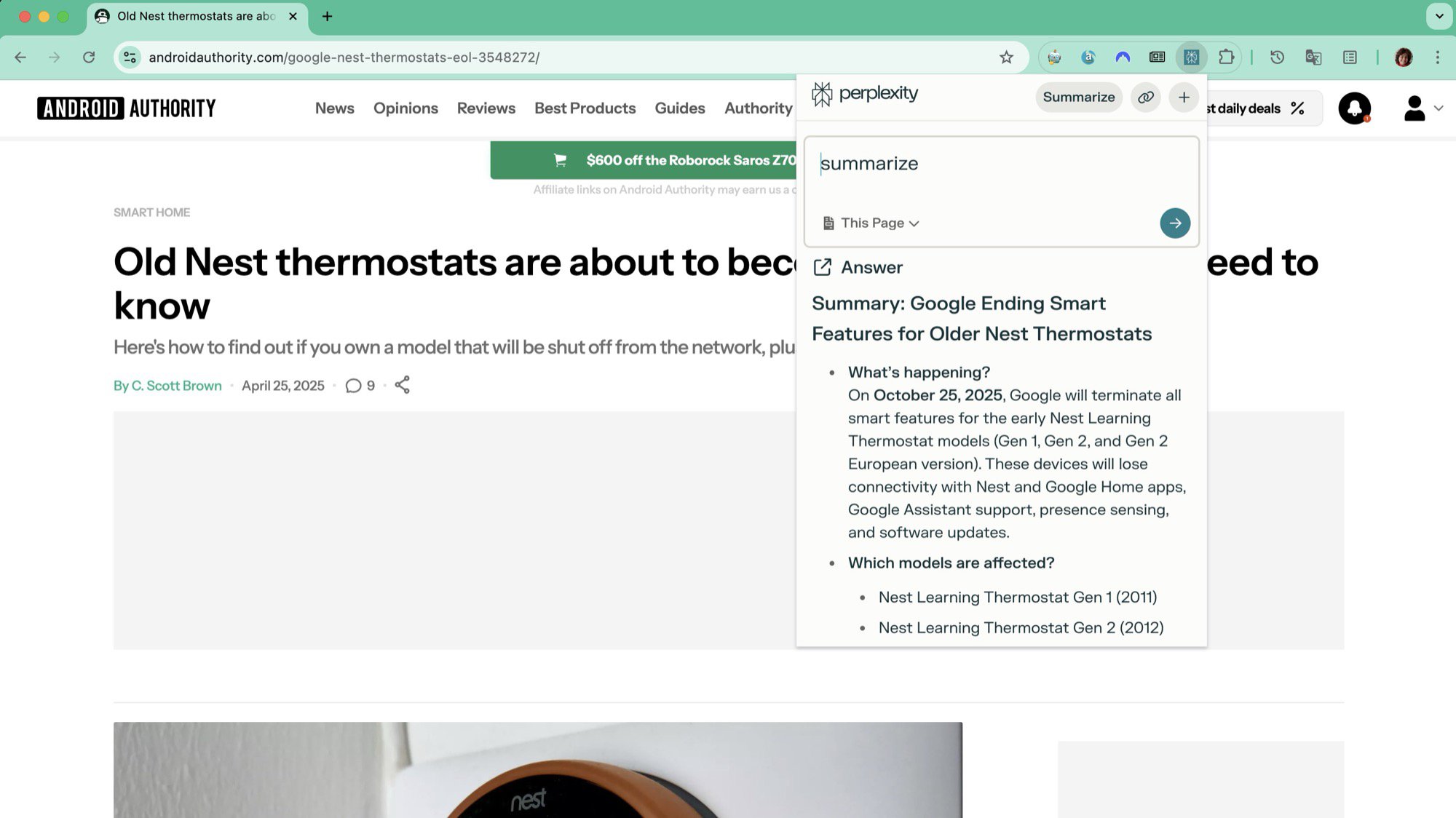
Rita El Khoury / Android Authority
Captura de pantalla
Quizás el botón en el que más hago clic en la extensión de Perplexity es Resumir. Solo toma la página de apertura actual y, lo adivinaste, la resume por mí. Como periodista que persigue noticias e historias, no tengo tiempo para leer todo todos los días; Tengo miembros del equipo para administrar, tecnología para probar y artículos para escribirme. Por lo general, me gusta los artículos más importantes que encuentro y salto el resto.
Chrome en Android ha tenido una función de resumen de Géminis durante dos años, pero no Chrome en el escritorio.
Con los resúmenes de Perplexity, puedo ponerme al día más rápido y de manera más eficiente en las noticias del día. Que mi Autoridad de Android Los colegas escribieron durante la noche, lo que trajo el ciclo de noticias de los Estados Unidos mientras cenaba anoche, o lo que mis colegas indios desenterraron temprano en la mañana antes de despertar. La perplejidad resume los artículos más importantes para mí.
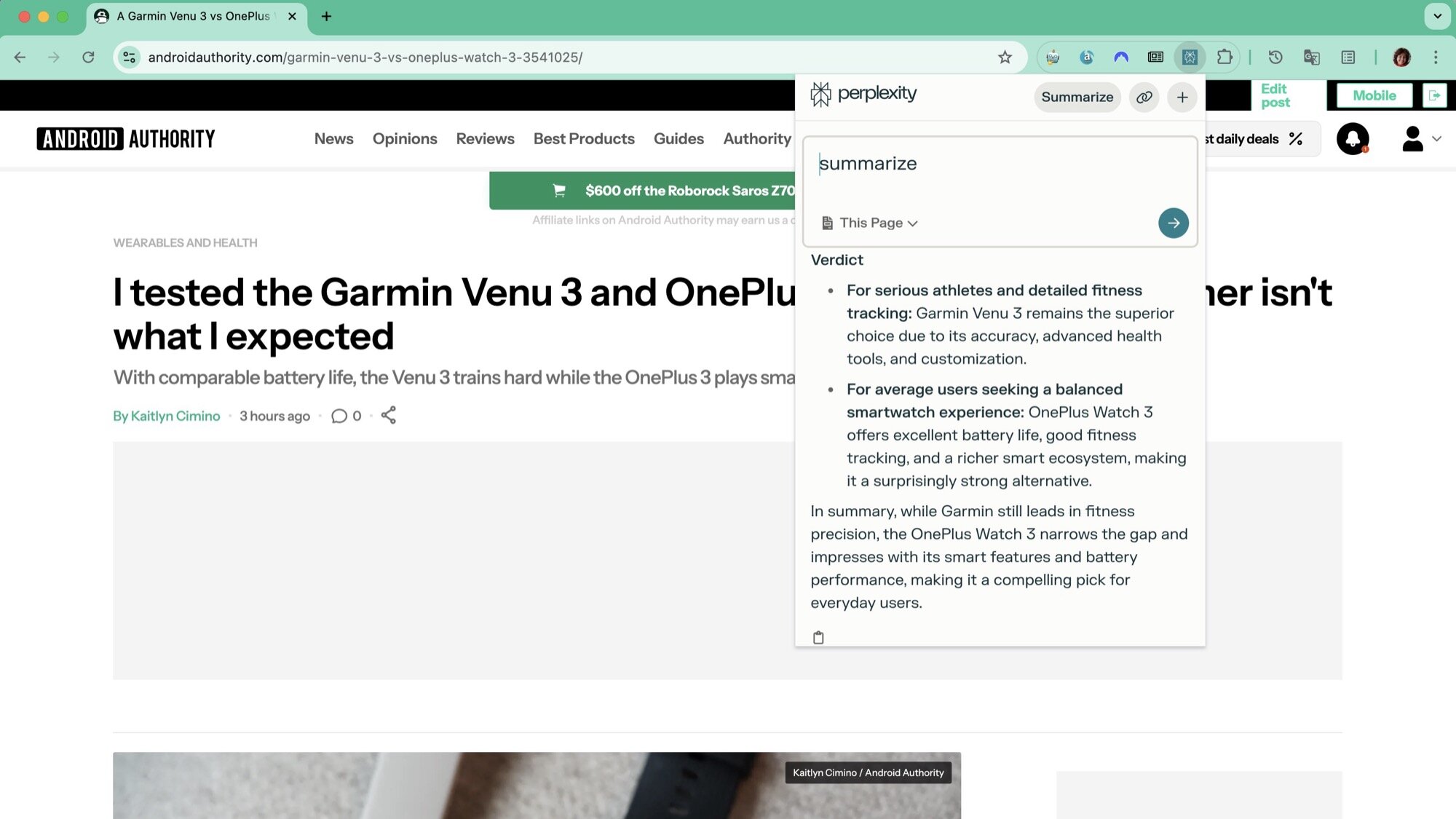
Rita El Khoury / Android Authority
Captura de pantalla
Me sorprende que los resúmenes de la página web de Gemini en Chrome en Android hayan estado disponibles durante casi dos años, pero todavía no se ha lanzado oficialmente en la versión de escritorio del navegador. Por qué tengo que usar extensiones de terceros para obtener esta característica simple está más allá de mí.
Buscando cualquier cosa y todo, con enfoque
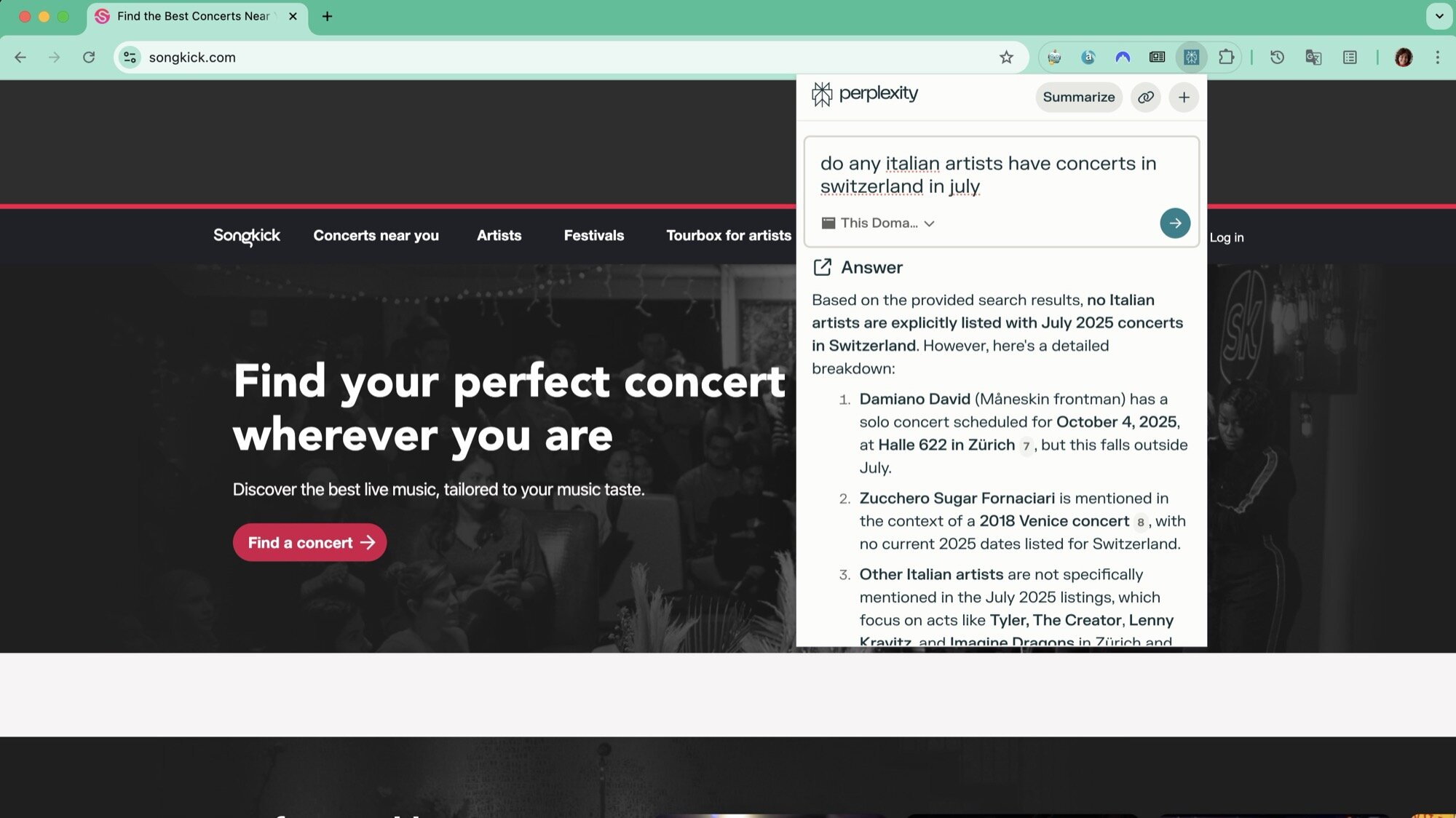
Rita El Khoury / Android Authority
Captura de pantalla
Mi segunda característica de extensión de perplejidad favorita es la capacidad de usarla como un cuadro de búsqueda para cualquier consulta simple o compleja, todo mientras limita la fuente a la página actual que estoy navegando o el dominio actual en el que estoy. Esto ha sido un tiempo de tiempo innumerable en los últimos meses mientras investigaba ideas de diseño, accesorios y equipos necesarios para mi nuevo hogar y jardín, así como mientras planaba algunos viajes y realizaba tareas diarias más mundanas como cocinar o trabajar.
Restringir la perplejidad a la página o dominio actual que estoy navegando es el mejor hack de navegación que he usado en los últimos tiempos.
Por ejemplo, puedo abrir Songkick.com y pedirle perplejidad para encontrarme conciertos en Suiza durante el mes de julio por artistas italianos. Los filtros de búsqueda más avanzados de Songkick no permiten ninguna búsqueda tan precisa como esta, especialmente ni un artista limitante por su nacionalidad. Pero me encanta la música italiana y no estoy buscando un artista en particular: aprovecharía cualquier oportunidad para atrapar ese lenguaje rico y melódico durante mi próximo viaje.
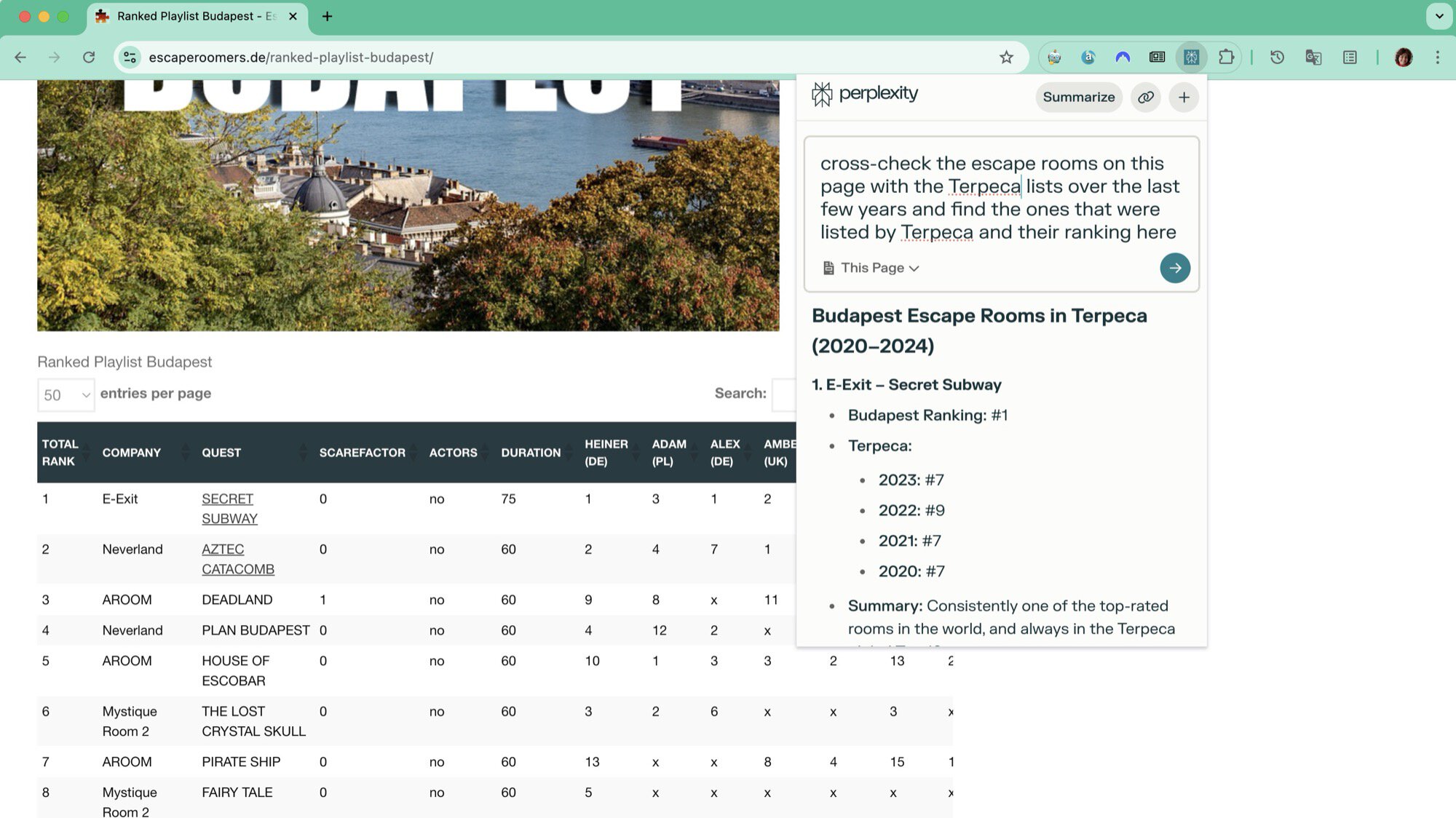
Rita El Khoury / Android Authority
Captura de pantalla
Cuando estaba buscando salas de escape dignas para mi próximo viaje a Budapest, encontré una pequeña lista ordenada de escaperos.de, pero quería verificar si estos habían sido enumerados en la clasificación de Terpeca (premios de la sala de escape mundial), por lo que pedí perplejidad para verificar la lista actual contra los ganadores anteriores y decirme qué habitaciones se han mencionado en ambos. La perplejidad no entendió por completo las clasificaciones de Terpeca, pero sí fue una mesa útil y me ayudó a reducir las habitaciones más generadas por ambos conjuntos de revisores.
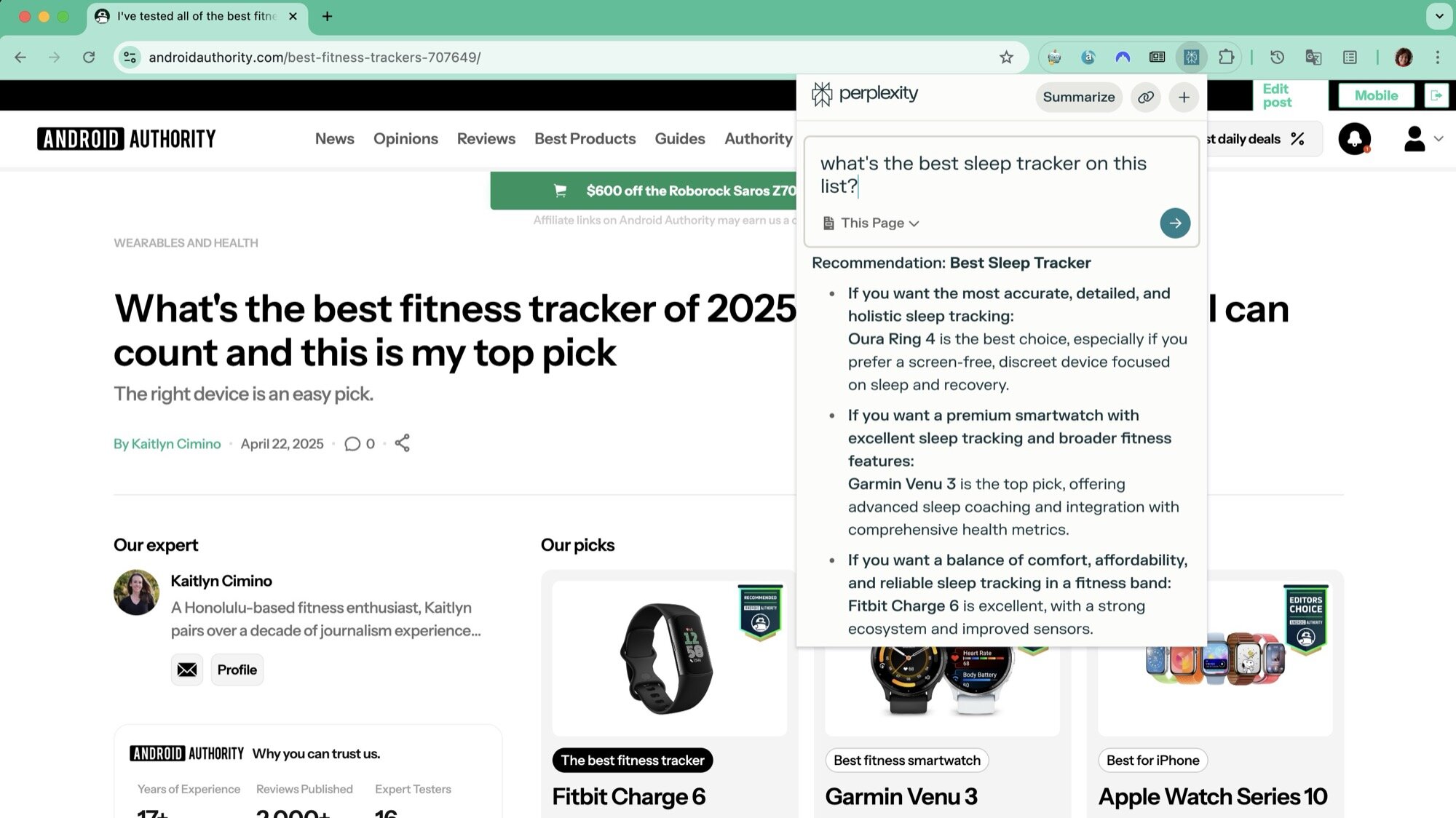
Rita El Khoury / Android Authority
Captura de pantalla
Hay docenas y docenas de otros ejemplos de cómo he estado usando la búsqueda enfocada de Perplexity. Encontrar el mejor rastreador de sueño en nuestro Autoridad de Android Lista de los mejores rastreadores de acondicionamiento físico, abrir una lista de los mejores bancos en línea en Francia y pedir los que tienen la compatibilidad de la billetera de Google, verificando las guías de sonido para los auriculares de ejercicios más estables, etc.
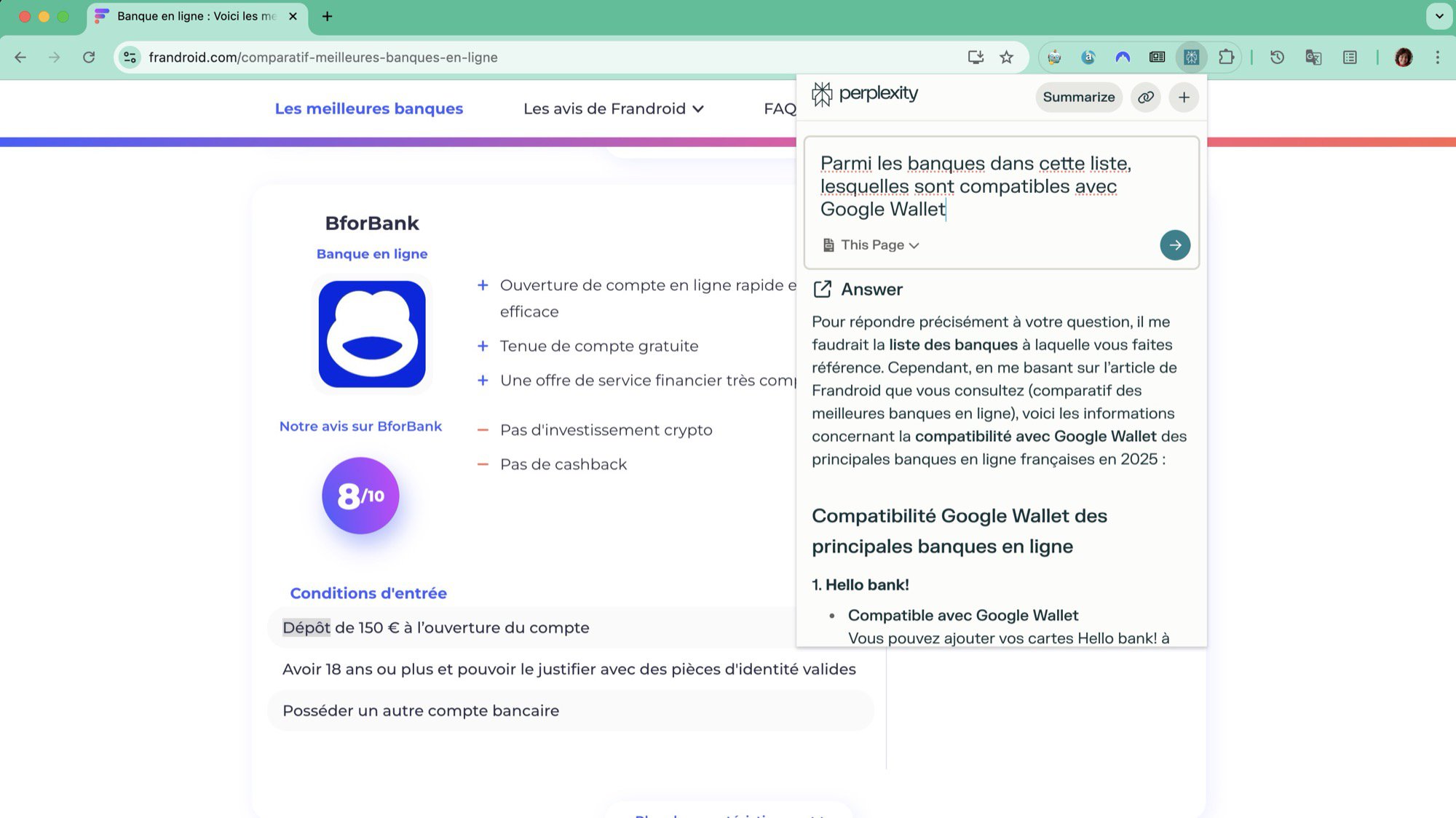
Rita El Khoury / Android Authority
Captura de pantalla
Eso sin mencionar todas las preguntas de decoración, materiales e ideas del hogar que he enviado a perplejidad mientras busqué inspiración. He hecho docenas de preguntas sobre las mejores opciones de madera de escritorio disponibles en Ilicut antes de comprar el roble superior de los dedos en el que estoy trabajando actualmente. Sobre la almohadilla para caminar más querida y resistente antes de comprar el A1 Pro. Acerca de los mejores dongles Bluetooth que me permitirían integrar los sensores de calidad del aire de SwitchBot y el escritorio IDasen de Ikea en la configuración amarilla de mi asistente de casa. Podría seguir para siempre.
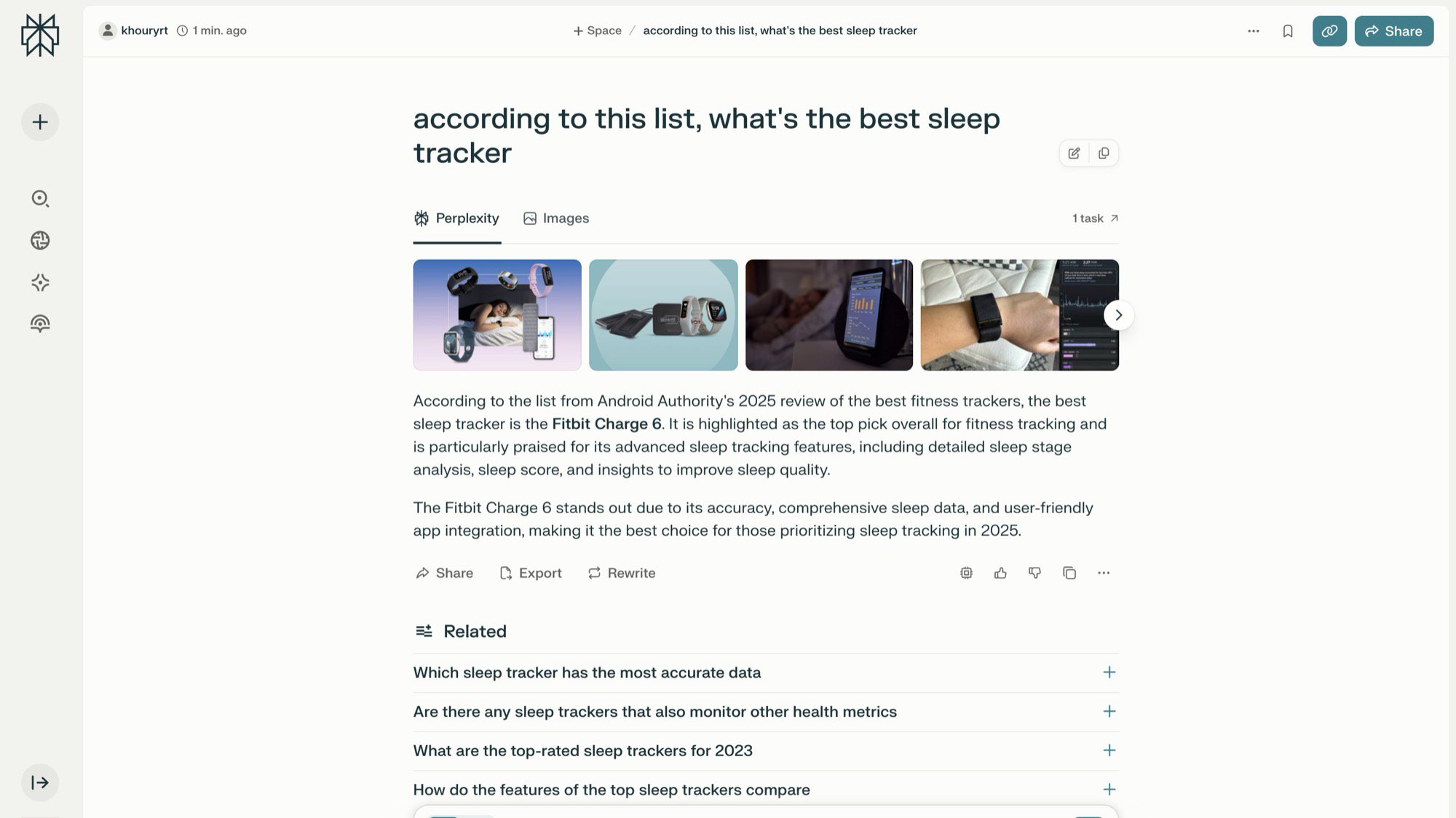
Rita El Khoury / Android Authority
Captura de pantalla
Mejor aún, en todos los casos, siempre puedo aparecer la respuesta actual y pedirle perplejidad para regenerar uno diferente con otro modelo de IA, verificar sus fuentes, ver todas las preguntas relacionadas y hacer un seguimiento con más preguntas propias. Me encanta que la perplejidad proporcione un tipo de punto de salto entre su extensión y su suite de características completa: es fácil activar la extensión para búsquedas rápidas y cerrarlo cuando obtengo mi respuesta, pero también es una buena manera de comenzar una inmersión más profunda una vez que llega la primera respuesta.
¿Por qué Google ya no está haciendo esto con Gemini en Chrome?
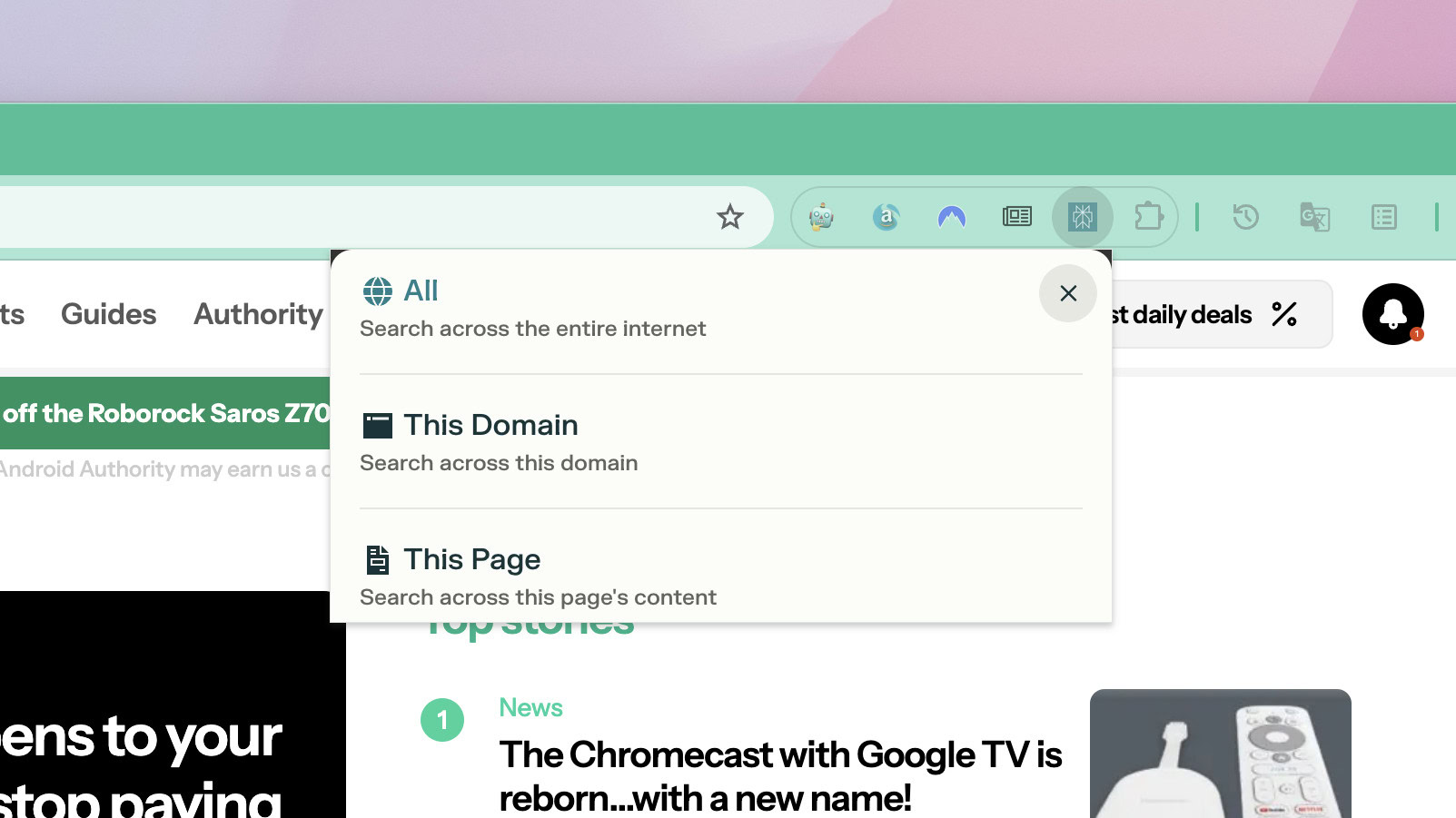
Rita El Khoury / Android Authority
La búsqueda enfocada de Perplexity es el tipo de función de IA que simplifica la vida que quiero cada vez que navego por la web. Una vez más, es un servicio de terceros con modelos de terceros que lo proporcionan dentro del propio navegador de Google, y todavía no entiendo cómo ya no hay una integración de Gemini con un conjunto de características similares cuando Google está tan ocupado atacando a Gemini por nuestras gargantas en todas las demás aplicaciones y servicios.
Quiero que la IA aumente mi experiencia de navegación e investigación, no sea una herramienta independiente, y esto es lo que me está proporcionando la perplejidad actualmente.
En lugar de abrir el sitio web de Gemini o convocar a la IA de Google con @Gemini en la barra de URL para hacer una búsqueda independiente, debe integrarse con los sitios y las páginas que ya estoy navegando. No quiero algo separado que encueste información de sitios aleatorios; Quiero la precisión de hacer preguntas y restringir consultas en los sitios y fuentes en las que confío. Quiero poder cavar en una página específica, hacer más preguntas al respecto, verificar con otra fuente y comparar productos o precios. Quiero que la IA aumente mi experiencia de navegación e investigación, no sea una herramienta independiente en la esquina que tengo que llamar de forma independiente.
Definitivamente escucharemos más sobre los planes Gemini más grandes de Google a finales de este mes durante la E/S, y con suerte, estas incluirán mejores integraciones de Gemini en las herramientas que usamos todos los días. Tomaría un ayudante de búsqueda de perplejidad en Chrome sobre Gmail Writing Aids cualquier día de la semana. Y mientras lo hacemos, permítanme agregar rápidamente páginas o fuentes a mi configuración de cuaderno y llamarlo cada vez que estoy navegando. Esa herramienta es invaluable, pero está tan oculta que la olvido nueve de cada 10 veces cuando la necesito.
Noticias
Resumen de noticias de AI: nueva aplicación meta ai, comportamiento del mal modelo de chatgpt [May 2025]

Al igual que los modelos de IA, AI News nunca duerme.
Cada semana, estamos inundados con nuevos modelos, productos, rumores de la industria, crisis legales y éticas y tendencias virales. Si eso no es suficiente, el rival AI Hype/Doom Chatter en línea hace que sea difícil hacer un seguimiento de lo que es realmente importante. Pero hemos examinado todo para recapitular las noticias de IA más notables de la semana de los pesos pesados como OpenAi y Googleasí como el ecosistema AI en general. Lea nuestro último resumeny vuelva a consultar la próxima semana para obtener una nueva edición.
Otra semana, otro lote de noticias de AI que se acercan.
Esta semana, Meta celebró su evento inaugural de Llamacon para desarrolladores de IA, OpenAi luchó con el comportamiento modelo, y LM Arena fue acusado de ayudar a las compañías de IA a jugar el sistema. El Congreso también aprobó nuevas leyes que protegen a las víctimas de los profundos, y una nueva investigación examina los daños actuales y potenciales de la IA. Además, Duolingo y Wikipedia tienen enfoques muy diferentes para sus nuevas estrategias de IA.
¿Qué pasó en el primer llameón de Meta?
Crédito: Chris Unger / Zuffa LLC / Getty Images
En Llamacon, la primera conferencia de Meta para desarrolladores de IA, los dos grandes anuncios fueron el lanzamiento de un Aplicación de meta ai independiente para competir más directamente con chatgpt y el API de llamasahora en una vista previa limitada. Siguiendo los informes de que Esto estaba en procesoEl CEO Sam Altman bromeó una vez que tal vez Operai debería hacer su propia aplicación de redes sociales, pero ahora eso es Según se informa que sucede verdadero.
También fuimos prácticos con la nueva aplicación Meta AI con alimentación de LLAMA. Para más detalles sobre Las principales características de Meta AILeer el desglose de Mashable.
Durante la nota clave de cierre de Llamacon, Mark Zuckerberg entrevistó a la CEO de Microsoft, Satya Nadella, sobre un montón de tendencias, que van desde capacidades de IA de agente hasta cómo debemos medir los avances de IA. Nadella también reveló que hasta el 30 por ciento del código de Microsoft está escrito por AI. No para ser superado, Zuckerberg dijo que quiere Ai para escribir la mitad del código de Meta por el próximo año.
Chatgpt tiene problemas de seguridad, va de compras
Meta ai y Chatgpt Ambos fueron arrestados esta semana para el sexting menores.
Operai dijo que este era un error y están trabajando para solucionarlo. Otro problema de ChatGPT esta semana hizo que la última actualización de GPT-4O sea demasiado chupada. Altman describió el comportamiento del modelo como “sycophant-y y molesto,” pero usuarios eran preocupado sobre los peligros de liberar un modelo como este, destacando problemas con el despliegue iterativo y el aprendizaje de refuerzo.
Operai incluso fue acusado de ajustar intencionalmente el modelo para mantener a los usuarios más comprometidos. Joanne Jang, jefe de comportamiento modelo de OpenAi, se subió a un Reddit AMA Para hacer control de daños. “Personalmente, la parte más dolorosa de las últimas discusiones de la sycophancy ha sido que las personas asuman que mis colegas están tratando de maximizar irresponsablemente el compromiso en aras”. escribió Jang.
A principios de la semana, Operai anunció nuevas funciones para hacer productos mencionados en Respuestas de chatgpt más comprables. La compañía dijo que no está ganando comisiones de compra, pero huele mucho a los inicios de un competidor de Google Shopping. Mencionamos OpenAi compraría cromo ¿Si Google se ve obligado a desestimarlo? Porque lo harían totalmente, FYI.
Velocidad de luz mashable
El fabricante de chatgpt ha tenido algunos problemas más con sus modelos recientes. La semana pasada, informamos que O3 y O4-Mini alucinan más que los modelos anteriores, por la propia admisión de Openai.
Cualquier persona en los EE. UU. Ahora puede registrarse en el modo Google AI
Mientras tanto, Google está avanzando con funciones de búsqueda con AI. El jueves, el gigante tecnológico anunció que está eliminando la lista de espera para Prueba el modo AI en los laboratoriospara que cualquiera mayor de 18 años en los Estados Unidos pueda probarlo. Hablamos con Robby Stein, vicepresidente de productos para Google Search, sobre cómo los usuarios han respondido a sus características de IA, el futuro de la búsqueda y la responsabilidad de Google a los editores.
Google también actualizó Gemini con Herramientas de edición de imágenes y cuaderno ampliadoes generador de podcast AI, a más de 50 idiomas. Bloomberg También informó que Google ha estado probando en silencio anuncios dentro de las respuestas de chatbot de terceros.
Estamos vigilando de cerca ese desarrollo final, y estamos muy Curioso cómo Google planea inyectar anuncios en la búsqueda de IA. ¿Confiarías en un chatbot que te dio respuestas patrocinadas?
Drama de la tabla de clasificación
Investigadores de AI Company Cohere, Princeton, Stanford, MIT y AI2, Publicado un artículo Esta semana, llamando a Chatbot Arena, para ayudar esencialmente a los pesos pesados de la IA a manejar sus resultados de evaluación comparativa. El estudio dijo que la popular herramienta de evaluación comparativa de crowdsourced de UC Berkeley permitió “pruebas privadas extensas” de Meta, Google, OpenAi y Amazon y les dio más datos rápidos, lo que “significativamente” mejoró sus clasificaciones.
En respuesta, LM Arena, el grupo detrás de Chatbot Arena, dijo que “hay una serie de errores de hecho y declaraciones engañosas en este artículo” y al corriente Una refutación puntiaguda por los reclamos del periódico en X.
Este tweet no está disponible actualmente. Puede estar cargando o ha sido eliminado.
El problema de los modelos de IA en comparación se ha vuelto cada vez más problemático. Los resultados de referencia son en gran medida autoinformados por las compañías que los liberan, y la comunidad de IA ha pedido más transparencia y responsabilidad por parte de terceros objetivos. Chatbot Arena parecía proporcionar una solución al permitir a los usuarios elegir las mejores respuestas en pruebas ciegas. Pero ahora las prácticas de LM Arena se han puesto en duda, alimentando aún más la conversación en torno a las evaluaciones objetivas.
Hace unas semanas, Meta se metió en problemas Para usar una versión inédita de su modelo Maverick Llama 4 en LM Arena, que obtuvo una clasificación alta. LM Arena actualizó sus políticas de tabla de clasificación, y se agregó la versión públicamente disponible de Llama 4 Maverick, ranking de manera más baja que la versión inédita.
Por último, LM Arena anunciado recientemente planea formar una empresa propia.
Los reguladores e investigadores abordan los daños del mundo real de la IA
Ahora que la IA generativa ha estado en la naturaleza durante algunos años, las implicaciones del mundo real han comenzado a cristalizar.
Esta semana, el Congreso de los Estados Unidos aprobó la Ley de “Take It Down”, que requiere que las compañías tecnológicas eliminen imágenes íntimas no consensuadas dentro de las 48 horas de una solicitud. La ley también describe un castigo estricto para los creadores de Deepfake. La legislación tenía apoyo bipartidista y se espera que sea firmada por el presidente Donald Trump.
La Oficina de Responsabilidad del Gobierno de los Estados Unidos no partidista (GAO) Publicado un informe sobre el impacto de la IA generativa en los humanos y el medio ambiente. La conclusión es que los impactos potenciales son enormes, pero exactamente cuánto se desconoce porque “los desarrolladores privados no divulgan alguna información técnica clave”.
Y en el reino de los daños terriblemente reales y específicos de la IA, un estudiar de Common Sense Media dijo que las aplicaciones complementarias de IA como el personaje. Ai y Replika son inequívocamente inseguros para los adolescentes. Los investigadores dicen que si eres demasiado joven para comprar cigarrillos, eres demasiado joven para tu propio compañero de IA.
Luego estaba el informe de que investigadores de la Universidad de Zúrich Bots de IA desplegados en secreto En el subreddit R/Changemyview para tratar de convencer a la gente de cambiar de opinión. Algunas de las identidades de BOT incluyeron una víctima de violación legal, “un consejero de trauma especializado en abuso” y “un hombre negro opuesto a las vidas negras”.
Otras noticias de AI …
En otras noticias, Duolingo está tomando un Enfoque de “AI-First”lo que significa reemplazar a sus trabajadores contractuales con AI siempre que sea posible. Por otro lado, Wikipedia anunciado Está adoptando un enfoque “humano primero” para su estrategia de IA. No reemplazará a sus voluntarios y editores con IA, sino que “usará AI para construir características que eliminen las barreras técnicas para permitir a los humanos en el centro de Wikipedia”.
Yelp desplegó un montón de funciones de IA esta semana, incluido un Servicio de contestadores con AI Eso requiere llamadas para restaurantes y gobernador Gavin Newsom quiere usar Genai Para resolver los legendarios atascos de California.
Temas
Inteligencia artificial OpenAi
-

 Startups12 meses ago
Startups12 meses agoRemove.bg: La Revolución en la Edición de Imágenes que Debes Conocer
-

 Tutoriales12 meses ago
Tutoriales12 meses agoCómo Comenzar a Utilizar ChatGPT: Una Guía Completa para Principiantes
-

 Recursos12 meses ago
Recursos12 meses agoCómo Empezar con Popai.pro: Tu Espacio Personal de IA – Guía Completa, Instalación, Versiones y Precios
-

 Startups10 meses ago
Startups10 meses agoStartups de IA en EE.UU. que han recaudado más de $100M en 2024
-

 Startups12 meses ago
Startups12 meses agoDeepgram: Revolucionando el Reconocimiento de Voz con IA
-

 Recursos11 meses ago
Recursos11 meses agoPerplexity aplicado al Marketing Digital y Estrategias SEO
-

 Recursos12 meses ago
Recursos12 meses agoSuno.com: La Revolución en la Creación Musical con Inteligencia Artificial
-

 Noticias10 meses ago
Noticias10 meses agoDos periodistas octogenarios deman a ChatGPT por robar su trabajo



































































































































































































































































































































































































































































































































































 Inside the OpenAI-DeepSeek Distillation Saga & Alibaba’s Most Powerful AI Model Qwen2.5-Max
Inside the OpenAI-DeepSeek Distillation Saga & Alibaba’s Most Powerful AI Model Qwen2.5-Max






































































































































































































































































































































































 De ChatGPT a mil millones de agentes
De ChatGPT a mil millones de agentes

























































































































































































































































































































































